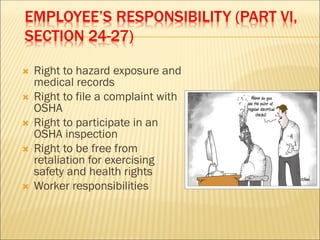Osha 1994 Section 24
In late 2016 OSHA published an update to its walking-working surface rule subpart D for general industry. OSHA requires employers to provide workers with hearing protection devices whenever noise exposure levels equals or exceeds OSHAs specifications unless the costs of engineering andor administrative controls are less than the cost of an effective hearing conservation program 29 CFR 191095.

Chapter 1 Occupational Safety And Health
CPL 02-00-148 OSHAs Field Operations Manual p.

. Its main goal is to ensure that employers provide employees with an environment free. On April 1 2017 the Occupational Safety Health Standards Board adopted a new regulation section 3342 - Workplace Violence Prevention in Health Care. OSHA Regulatory Requirements.
Employers that fall within the scope of this standard must comply with this regulation including implementation of a written workplace violence prevention plan procedures assessments. The Occupational Safety and Health Act of 1970 is a US labor law governing the federal law of occupational health and safety in the private sector and federal government in the United StatesIt was enacted by Congress in 1970 and was signed by President Richard Nixon on December 29 1970. But noise that exceeds 115 dBA should be incorporated into the overall TWA noise exposure determination see Section IIJ2- OSHA Noise Standards for more information.
CalOSHA - Consultation Program. Subpart D applies to all general industry workplaces and covers all walking-working surfaces unless specifically excluded by an individual section of the subpart. In either case orient the microphone so it points straight up--you might need to adjust the clip to find a functional position.

Chapter 1 Occupational Safety And Health

Chapter 1 Occupational Safety And Health

Chapter 1 Occupational Safety And Health

Chapter 1 Occupational Safety And Health
0 Response to "Osha 1994 Section 24"
Post a Comment